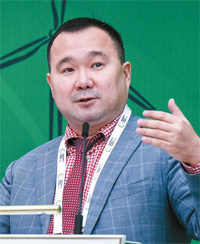Green Energy and Sustainable Development
Kazakhstan has an inexhaustible solar and wind energy potential

Petroleum's questions were answered by Arman Kashkinbekov, Honorary General Director and member of the Board of Directors of the Renewable Energy Association of Kazakhstan, member of the National Council of Public Trust, co-founder, and an honorary member of the BOLASHAQ Association.
– According to the World Economic Forum report, in the rating of transition to new energy sources for 2021, Kazakhstan took only 83rd place among 115 countries participating in the rating. As you can see, there is nothing to brag about yet. Why, in your opinion?
– As they say, haste makes waste. Kazakhstan has chosen its specific path of clean energy development, different from many countries. The concept for the transition to a green economy, approved by the first President – Elbasy Nursultan Nazarbayev, approved in 2013, clearly defined the parameters for the development of renewable energy sources: 3% by 2020, 10% (now 15%) by 2030, 50% by 2050. President of Kazakhstan Kassym-Jomart Tokayev made adjustments at a recent, large meeting on energy held at the end of May 2021: the share of RES by 2030 was increased from 10% to 15%, and by 2060 to 80%, where renewable sources and gas should prevail, which is also reflected in the strategy of low-carbon development adopted at the meeting of the Supreme Council for Reforms.
Our country, as you know, is based on coal generation, the share of which reaches 70%, and the primary assets such as CHPs, state district power stations, and networks have long been worn out, morally and physically outdated, and are subject to immediate renovation. Therefore, the issue of the country's readiness to switch to clean energy sources must be considered comprehensively.
There is a well-founded proposal to develop a country concept for energy development, including renewable and alternative energy, for, say, ten years, although the further the better. On behalf of President Kassym-Jomart Tokayev, the Ministry of Energy of Kazakhstan is updating and adjusting the energy balance until 2035. The work is not easy, but it is required in the current situation. The rolling blackouts that have occurred are, unfortunately, confirmation of this.
In addition, the world does not stand still and, as you know, scientific and technological progress has never been stopped by anyone, not only stopped but even slowed down. There are so-called alternative sources, such as hydrogen, industrial gases, coalbed gas methane, and others. All of them are very relevant for industrial and very energy-intensive Kazakhstan. In this connection, in February 2021, at a meeting of the National Council of Public Trust, the President instructed the government to develop an appropriate bill. The deadline is until the end of 2022, and the adoption is the first quarter of 2023. That is, it is not a long wait for it.
It will significantly help our industrial enterprises in their inevitable transformation and transition to "green rails", will allow them to maintain, to some extent, the competitiveness of their products on world markets, and therefore increase the number of jobs and mandatory payments to the budget.
Special discussions are currently going on around the possible use of peaceful atoms in Kazakhstan. The issue is not easy, given the radiophobia among the population, which is fully justified due to the work of the Semipalatinsk nuclear test site on the territory of the country – a great tragedy of the Kazakh people. Nevertheless, the Government and the National Welfare Fund are actively engaged in this issue. I would like to believe that the final decision or proposal will be submitted to the public space for a broad discussion.
Ratings can be, as you know, different. Of course, we should pay attention to them, but also act according to our national, reasonable plan.



